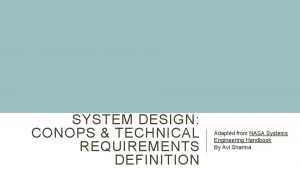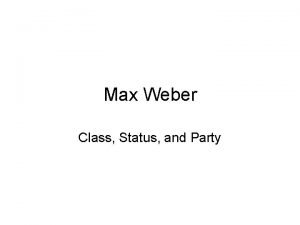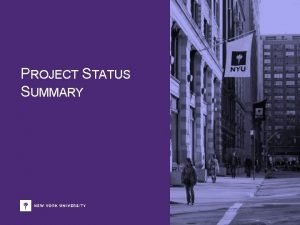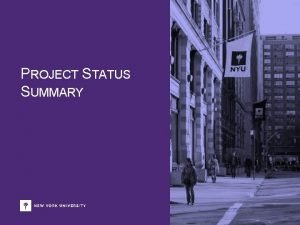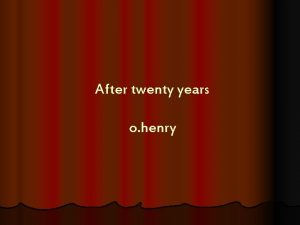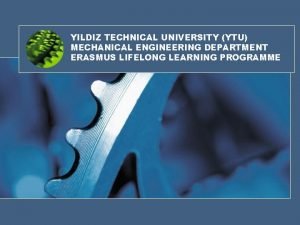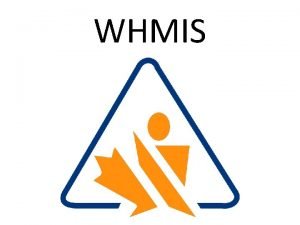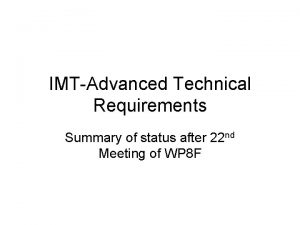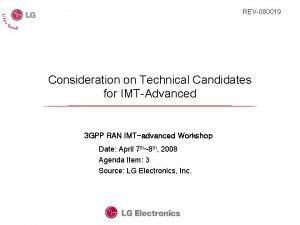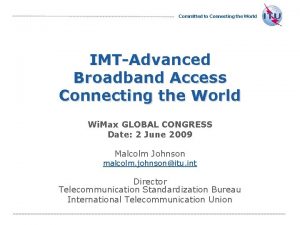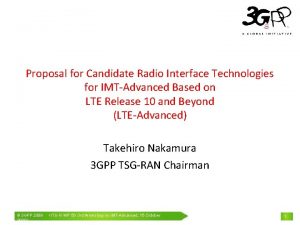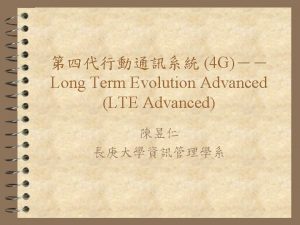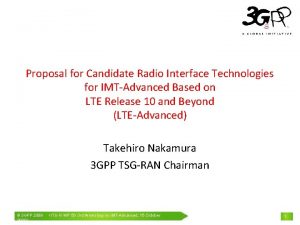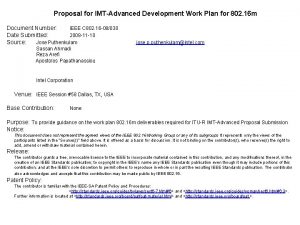IMTAdvanced Technical Requirements Summary of status after 22



![Draft [report on] requirements related to technical system performance for imtadvanced radio interface(s) [IMT. Draft [report on] requirements related to technical system performance for imtadvanced radio interface(s) [IMT.](https://slidetodoc.com/presentation_image_h2/15deed2d92c1df98b77c21e2b5d8d59b/image-4.jpg)







![References • Draft [Report on] Requirements Related To Technical System Performance for IMT -Advanced References • Draft [Report on] Requirements Related To Technical System Performance for IMT -Advanced](https://slidetodoc.com/presentation_image_h2/15deed2d92c1df98b77c21e2b5d8d59b/image-12.jpg)
- Slides: 12

IMT-Advanced Technical Requirements Summary of status after 22 nd Meeting of WP 8 F

Outline • Overview of Circular Letter on IMTAdvanced • Overview of IMT. TECH • Relationship between IMT. TECH and Circular Letter • More detailed look at current draft of IMT. TECH • Next steps and timeline

Circular Letter on an invitation to propose candidate radio interface technologies for IMT-Advanced • Main body • Annex 1: Background on IMT-Advanced • Annex 2: Submission and evaluation process and consensus building • Annex 3: Requirements related to service capabilities • Annex 4: Requirements related to technical system performance • Annex 5: Spectrum related issues including relevant requirements • Annex 6: Submission guidelines and template for submission • Annex 7: Evaluation guidelines and criteria and methodology • Annex 8: Relevant ITU-R Recommendations, Reports and others • Annex 9: IPR Policy
![Draft report on requirements related to technical system performance for imtadvanced radio interfaces IMT Draft [report on] requirements related to technical system performance for imtadvanced radio interface(s) [IMT.](https://slidetodoc.com/presentation_image_h2/15deed2d92c1df98b77c21e2b5d8d59b/image-4.jpg)
Draft [report on] requirements related to technical system performance for imtadvanced radio interface(s) [IMT. TECH] 1. 2. 3. 4. 5. 6. 7. 8. 9. Introduction Scope and Purpose Related Documents Minimum Requirements Technological Items Required To Describe Candidate Air Interface Required technology criteria for evaluation Conclusions Terminology, abbreviations Appendices

Relationship between IMT. TECH and Circular Letter • IMT. TECH chapter 4 = CL Annex 4 • IMT. TECH chapter 5 -> CL Annex 6 • IMT. TECH chapter 6 -> CL Annex 7 – Also provides input to IMT. EVAL, which forms primary basis of CL Annex 7 • IMT TECH chapter 3 -> CL Annex 8

Key progress on IMT. TECH at 22 nd meeting of WP 8 F • Minimum requirements chapter – – Created Sub-sections agreed and baseline text All numbers in square brackets Baseline for Circular Letter Annex 4 created • Technological items to describe air interface – Items (sub-sections) agreed – No discussion on text • Required technology items for evaluation – Included all minimum requirements – Other items (headings) agreed – No discussion on text • Deleted general requirements section – Input material retained in an appendix

Minimum requirements* • Cell spectral efficiency – Values to be set per test environment, downlink/uplink separately • Peak data rate – Defined as peak spectral efficiency with data rates given as an example – Some countries would prefer peak data rate, current text all in square brackets • • Cell edge user throughput Latency – Control plane – Transport – Placeholder for Qo. S • Mobility – 4 classes defined: stationary, pedestrian, vehicular, high speed – Mapped to test environments – Optimisation of performance to mobility class defined • Handover – Support for continuous service – Interupption times will be set: intra/inter-frequency, [inter-system] * Requirements (and other criteria) evaluated according to details in IMT. EVAL/Annex 7 of Circular Letter

Technological items required to describe candidate air interface (1) 1. Multiple access methods 2. Modulation scheme 3. Error control coding scheme 4. Physical channel structure and multiplexing 5. Frame structure 6. Spectrum capabilties 7. Support of advanced antenna capabilties 8. Link adaptation and power control 9. RF channel parameters 10. [Scheduling algorithm]

Technological items required to describe candidate air interface (2) 11. Radio interface architecture and protocol stack 12. Positioning 13. Support of multicast and broadcast 14. Qo. S support and management 15. Security aspects 16. Network topology 17. Mobility management and RRM 18. Interference mitigation within radio interface 19. Synchronisation 20. Power efficiency

Required technology criteria for evaluation* • Minimum requirement parameters • Other parameters for evaluation: – Vo. IP capacity – [Technology complexity] – Cell coverage – CCDF of user throughput – Qo. S – Capacity considerations/supported user density * Requirements (and other criteria) evaluated according to details in IMT. EVAL/Annex 7 of Circular Letter

Next steps and timeline • Correspondence group on ITU Jive forum, concluding 11 th November 2007 • IMT. TECH and Circular Letter to be finalised at next WP 8 F meeting – 28 th January – 1 st February 2008 • Work to be done: – – – – Include IMT-Advanced Common Text into the introduction Agree on peak data rate/spectral efficiency definition Agree all numbers for minimum requirement parameters Discuss and harmonise text in chapter 5 Discuss and harmonise text in chapter 6. 2 Consider requirements currently held in Appendix 3 Review appendices 1 and 2 • Obviously take into account new contributions to 23 rd meeting!
![References Draft Report on Requirements Related To Technical System Performance for IMT Advanced References • Draft [Report on] Requirements Related To Technical System Performance for IMT -Advanced](https://slidetodoc.com/presentation_image_h2/15deed2d92c1df98b77c21e2b5d8d59b/image-12.jpg)
References • Draft [Report on] Requirements Related To Technical System Performance for IMT -Advanced Radio Interface(s) [IMT. TECH], ITU-R document 8 F/1322 attachment 6. 8


